Solution 1 – Disable hardware acceleration
The most common workaround for black screen issues in Google Chrome is to disable GPU compositing on all pages. In case you don’t know how to do that, follow these instructions:
- Create Google Chrome shortcut on Desktop (in case you don’t have it).
- Right-click the shortcut, and select Properties.
- Click on Shortcuts tab.
- In Target window, add the following text: “[space]–disable-gpu“ (so the path should look like chrome.exe” –disable-gpu”).
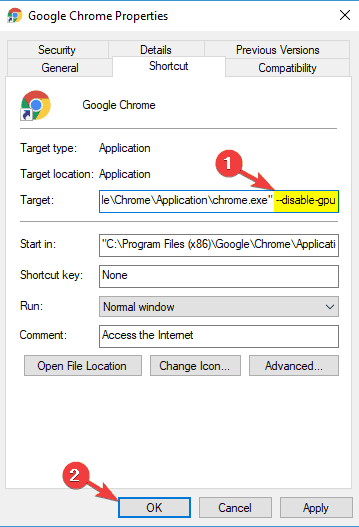
- Save changes.
- Now, open Chrome and go to Settings > Show advanced settings.
- Now, just disable the Use hardware acceleration when available option.

- Restart Chrome.
This solution proved to be the right one in most of the cases, and for the majority of users. However, if you’re still experiencing the black screen issues in Google Chrome, move on to another solution.
Solution 2 – Disable plugins
Sometimes certain plugins can cause a black screen to appear in your browser. A plugin might not be fully compatible with your version of Chrome or it might be buggy causing the issue to appear.
To fix the problem, you need to find and disable the problematic plugin. This is quite simple, and you can do it by following these steps:
- Click the Menu icon and choose More tools > Extensions.
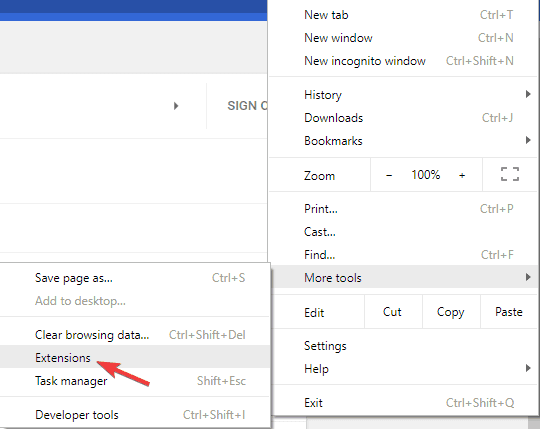
- List of all extensions will now appear. Disable all extensions by clicking the switch icon next to the extension’s name.
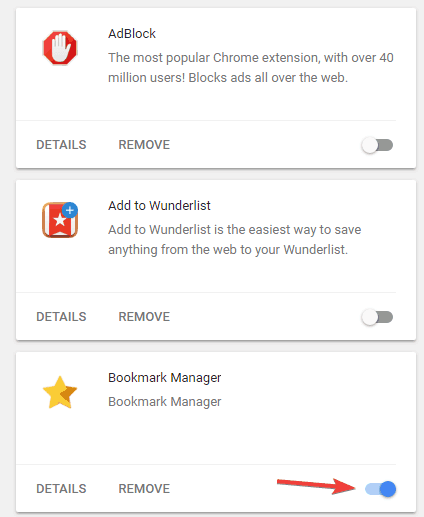
- After disabling all extensions, restart Chrome and check if the problem is still there.
If the issue doesn’t reappear, you can start enabling extensions one by one until you find the one that is causing the issue. Once you find it, you can keep it disabled or remove it from Chrome.
Disabling plugins can be a nightmare, but here is the perfect solution for you!
Solution 3 – Disable Chrome flags
Another solution is to disable some Chrome flags, in order to get rid of the black screen problem. The flags we’re looking to disable are:
- GPU compositing on all pages
- Threaded compositing
- Do SHOW Presents with GD
Here’s what you need to do:
- Enter the following URL in the Chrome address bar: chrome://flags/.
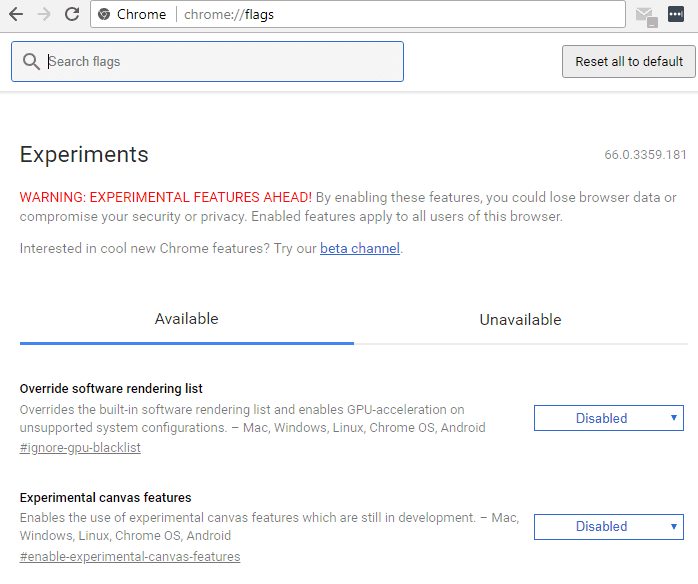
- Look out for the above-mentioned flags, and disable them.
- Restart Chrome.
This solution proved to be helpful only to some users, as others reported it as unsuccessful. Nevertheless, you should try it, and see if disabled flags make any difference.
Solution 4 – Resize Chrome
According to users, you might be able to fix this problem simply by resizing Chrome. To do that, just click and hold Google’s title bar in order to resize it. After doing that, restore Chrome back to the original size and check if the problem is still there.
Keep in mind that this is just a workaround, so it won’t permanently solve this issue. If the black screen reappears, simply resize your browser again and the problem will be temporarily solved.
Solution 5 – Run Chrome in Compatibility mode
Compatibility mode is a useful feature of Windows that allows you to run older applications. Speaking of which, many users reported that they fixed black screen issues in Google Chrome simply by enabling Compatibility mode. To do that, just follow these steps:
- Locate Chrome shortcut, right-click it and choose Properties from the menu.
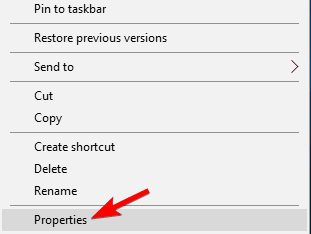
- When Properties window opens, navigate to Compatibility tab and check Run this program in compatibility mode for. Now select the desired version of Windows. Many users recommend using Windows 7, so you might do that. Lastly, click Apply and OK to save changes.
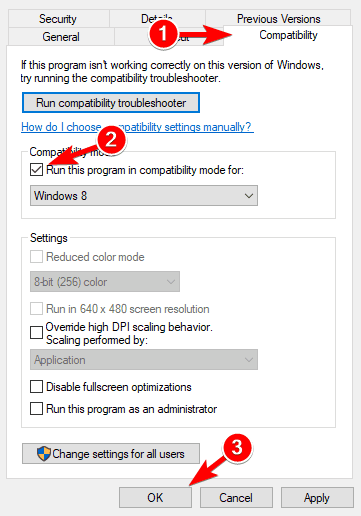
After enabling Compatibility mode, try starting Chrome again. If the issue reappears, repeat the same steps, but this time click Change settings for all users button. In addition, you might want to try different versions of Windows and check if that helps.
Solution 6 – Add -no-sandbox launch parameter
According to users, you might be able to fix the problem simply by adding -no-sandbox parameter to Chrome’s shortcut. In case you don’t know, Google Chrome uses a Sandbox mode in order to separate its processes.
This means that even if your browser encounters malware, the malware will be contained thanks to the Sandbox mode.
As you can see, Sandbox mode is a useful security feature, but sometimes it can cause black screen issues in Google Chrome. To fix the problem, some users are suggesting to disable Sandbox mode, and to do that, you need to follow these steps:
- Right-click Chrome’s shortcut. Choose Properties from the menu.
- Navigate to the Shortcut tab and in the Target field add –no-sandbox at the end. Now click Apply and OK to save changes.
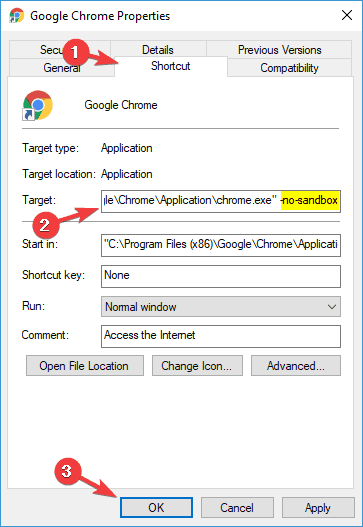
Solution 7 – Reset Google Chrome
If you’re having problems with the black screen in Chrome, you might be able to solve the problem simply by resetting Chrome to default. By doing that you’ll reset all its settings and remove all extensions.
Keep in mind that this will remove all your bookmarks and history, so be sure to enable syncing or export your data. You can do that easily and efficiently with these tools.
To reset Google Chrome, you need to do the following:
- Click the Menu icon in Chrome and choose Settings from the menu.
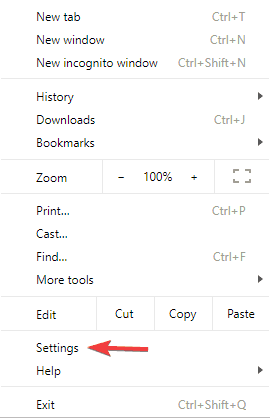
- When Settings tab opens, scroll all the way down and click Advanced.
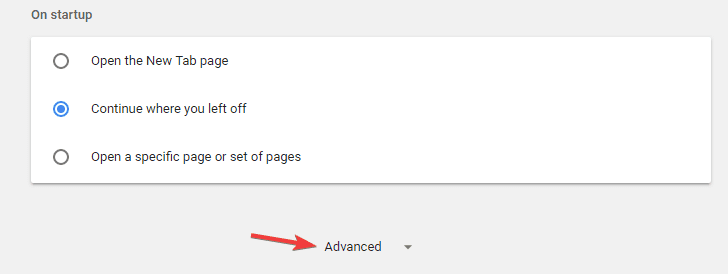
- Navigate to Reset and clean up section and click Reset settings.

- Click the Reset button to confirm.
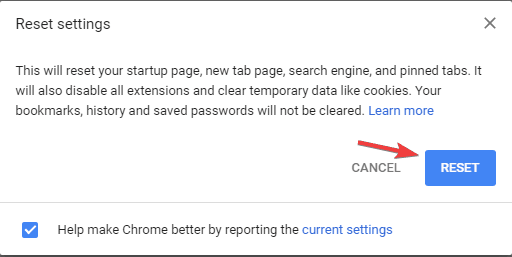
Wait for few minutes while Chrome resets to default. Now check if the problem is still there.
Solution 8 – Reinstall Chrome
According to users, sometimes in order to fix this problem you need to reinstall Chrome completely. Reinstalling Chrome might remove all your bookmarks and history, so you should export them or enable syncing.
There are several ways to uninstall Chrome, but the best one is to use uninstaller software. In case you’re not familiar, uninstaller software is a special application that will remove the selected application along with all of its files and registry entries.
There are many great uninstaller applications, but one of the best is IOBit Uninstaller, so be sure to try it out. Once you remove Chrome with this tool, install it again and check if the problem is resolved.
In addition, you can also try using Beta or Canary version of Chrome. These are experimental versions, but they offer the latest bug fixes, so using them might be a good temporary solution.
If you consider switching to another browser, we suggest checking our list of the best lightweight browsers.
We also recommend UR browser. This is the perfect solution for those who value their privacy, among other qualities.
Editor's recommendation
